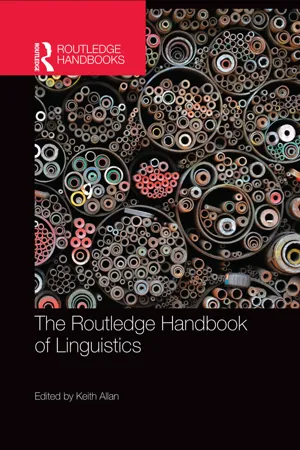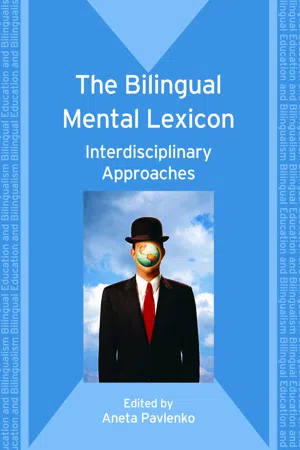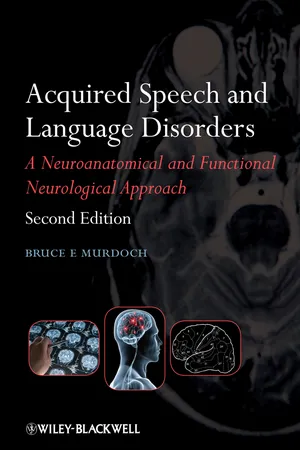Languages & Linguistics
Neurolinguistics
Neurolinguistics is the study of the relationship between language and the brain. It explores how the brain processes and produces language, as well as how language disorders and impairments manifest in the brain. By examining the neural mechanisms underlying language, neurolinguistics contributes to our understanding of language acquisition, comprehension, and production.
Written by Perlego with AI-assistance
Related key terms
7 Key excerpts on "Neurolinguistics"
- eBook - ePub
- Keith Allan(Author)
- 2015(Publication Date)
- Routledge(Publisher)
Neurolinguistics Mind, brain, and language David Kemmerer19.1 Introduction
The goal of Neurolinguistics is to understand how the cognitive capacity for language is subserved by the biological tissue of the brain. This interdisciplinary field of research began in the mid-nineteenth century, and by the early twentieth century several basic aspects of the neural architecture of language had already been discovered, such as left-hemisphere dominance and the strong reliance of speech perception and production on certain regions in the temporal and frontal lobes. These initial insights came primarily from investigations of brain-damaged patients who displayed fairly consistent correlations between, on the one hand, particular patterns of impaired and preserved linguistic abilities, and on the other hand, particular patterns of lesioned and intact brain structures. But even though that first wave of neuropsychological exploration was of great historical importance, the value of the studies was limited by their lack of precision on both sides of the language–brain relationship. From the mid-twentieth century up to the present, however, the whole field evolved quite dramatically for a variety of reasons, including the maturation of modern linguistics, the cognitive revolution in psychology, the emergence of computer science and artificial intelligence, and the invention and progressive refinement of numerous brain mapping methods. Due to these developments, Neurolinguistics is now a vibrant, rapidly growing field in which researchers with different backgrounds frequently collaborate to conduct empirical and theoretical studies on diverse topics.The following synopsis begins by summarizing several kinds of cortical organization as well as the most commonly used brain mapping methods. It then provides a selective review of recent hypotheses and findings about the neural representation and processing of spoken word forms, printed word forms, word meanings and sentences. Although some of the most well-supported contemporary perspectives are covered, space limitations only allow a small amount of material to be included, far less than is actually available in the relevant literature. Further information can be found in the references listed under ‘Further reading.’ - eBook - ePub
Applying Linguistics in the Classroom
A Sociocultural Approach
- Aria Razfar, Joseph C. Rumenapp(Authors)
- 2013(Publication Date)
- Routledge(Publisher)
2 Neurolinguistics Rethinking Language in the Flesh Learning Goals- Identify the biological components of the brain usually associated with language.
- Identify major disorders, illnesses, symptoms, and causes affecting language learning and use.
- Summarize recent research on Neurolinguistics.
- Understand different theories within Neurolinguistics and language learning.
- Identify differences between deafness, aphasias, and cognitive disabilities.
- Summarize the learning and the critical age hypothesis.
KEY TERMS/IDEAS: Neurolinguistics, Broca’s aphasia, cognition, embodied cognition, epigenetics, Wernicke’s aphasiaIntroductionNeurolinguistics is the study of how language processes are connected to the brain. It combines the fields of neuroscience as well as cognitive linguistics. Neuroscience as a whole is mostly concerned with the physical and biological aspects of language. Its approach to language and learning is for the most positivistic which means it aims to dissect language into experimentally isolatable variables which is a problematic starting point. This lends itself to a “FLESH” based perspective on cognition and language where questions related to interaction, culture, history, and ideology are ignored at best and rejected at worst. The central questions of what is language? and what is the nature, function, and purpose of language? are answered in terms of code and performance (questions 1 and 2 from Chapter 1 ). For the most part, there is little attention to questions 3 and 4 outlined in Chapter 1 : the semiotic and ideological dimensions of language, the “HEART” of language.Given its assumptions of human nature and nurture as external to cognitive activity, language is reduced to an internal, intrapersonal process where meaning making and relational aspects such as affect/affinity in the sociocultural sense are often not taken into account. Furthermore, the notion of context within neurolinguistic approaches is virtually zero. Neurolinguistics draws heavily on biological and cognitive sciences where the brain is treated as a self-contained, independent entity. The dominant metaphor of mind is embodiment - Victor M. Rentel, Samuel A. Corson, Bruce R. Dunn(Authors)
- 2017(Publication Date)
- Routledge(Publisher)
However, such investigations provide usable information about language only to the degree that they conform to an acceptable linguistic research paradigm, as well as to a biological one. Yet, at present there is no single universally received research paradigm for the study of language comparable to those established for the physical sciences (Kuhn 1970). In fact, the direction of linguistic, psycholinguistic and socio-linguistic research has changed markedly over the last decade and continues to change even now. There is, for example, much debate about 1) what constitutes a realistic yet analyzable segment of language, 2) which proposed linguistic units and dimensions have psychological reality, and 3) what analytic techniques provide fruitful insights into language structure, use and acquisition. Until such major issues are resolved, it will be difficult to determine what neurological investigations using rather traditional definitions of language tell us about neurolinguistic processes.On the other hand, it would be absurd to halt neurolinguistic investigations until a broader and more universally accepted language research paradigm has been established. The current state of research and research paradigms available in the various language disciplines, however, suggests that a review of current neurolinguistic findings in the context of related developments in linguistic theory and psycholinguistic research may yield both new and more refined interpretations of the literature in Neurolinguistics; thus the goal and topic of the present chapter.I will begin with a historical perspective on changing linguistic and psycholinguistic models including a discussion of some of the major questions currently under debate and then discuss some recent investigations of perception, information storage and information processing that bear directly on our understanding of how language is learned and used. Next, neurolinguistic studies will be interpreted in light of this work. What emerges will be a perspective on language and brain mechanisms which stresses the integrative ‘whole brain’ nature of language activities and their related brain mechanisms. Finally, a section will be devoted to the specific implications of this view for understanding the reading process and how children learn to read.LINGUISTIC PERSPECTIVES
Language scholars generally identify two major periods or movements in the history of twentieth century American linguistics: the Structuralist1- eBook - ePub
The Future of the Brain
Essays by the World's Leading Neuroscientists
- Gary Marcus, Jeremy Freeman(Authors)
- 2014(Publication Date)
- Princeton University Press(Publisher)
LANGUAGELanguage is uniquely human, at least in the sense of our being able to talk not just about the here and now but about the abstract, the complex, the future, and the hypothetical. Language is also uniquely difficult to study; there are no direct animal models (though birdsong can be informative), and sharp ethical limits constrain what techniques can be used. If most work in neuroscience is on vision and motor control, it’s partly because those areas of the mind are more easy to study.David Poeppel argues that the key challenge in understanding language is to bridge between a vocabulary of neural elements (such as axons and cell bodies) and a vocabulary of linguistic elements (such as nouns and verbs). He suggests that techniques such as brain imaging have not been adequate to the task but give hints into research that might take us closer. Simon Fisher explores an analogous set of challenges in bridging between DNA, genes, brains, and complex behavior, focusing on the case of human language. As he puts it, “we are at a watershed in genomics research, one that is set to transform multiple fields of neuroscience in unprecedented ways.”THE NEUROBIOLOGY OF LANGUAGE David Poeppel The Origin and Transformation of Research on the Neurobiology of LanguageThe ease, speed, and apparent automaticity with which we can greet a friend, follow a conversation, or read this sentence belie the considerable complexity of such seemingly effortless language tasks. Even the most elementary linguistic “event,” say recognizing a single spoken word (“prose”), requires the coordination of a number of complex subprocesses (for example, analysis of the basic acoustic signal attributes, phonetic decoding, look-up/matching of the item in one’s mental dictionary, retrieval of the word’s pronunciation instructions, meaning, and grammatical specifications). And comprehending or producing a sentence (“Composing prose is an arduous affair”) entails the subtle orchestration of dozens of underlying component operations. - eBook - ePub
The Bilingual Mental Lexicon
Interdisciplinary Approaches
- Aneta Pavlenko(Author)
- 2009(Publication Date)
- Multilingual Matters(Publisher)
Chapter 1Neurolinguistic Contributionsto Understanding the BilingualMental Lexicon
RENATA MEUTERIntroduction
Many bilinguals will have had the experience of unintentionally reading something in a language other than the intended one (e.g. MUG to mean mosquito in Dutch rather than a receptacle for a hot drink, as one of the possible intended English meanings), of finding themselves blocked on a word for which many alternatives suggest themselves (but, somewhat annoyingly, not in the right language), of their accent changing when stressed or tired and, occasionally, of starting to speak in a language that is not understood by those around them. These instances where lexical access appears compromised and control over language behavior is reduced hint at the intricate structure of the bilingual lexical architecture and the complexity of the processes by which knowledge is accessed and retrieved. While bilinguals might tend to blame word finding and other language problems on their bilinguality, these difficulties per se are not unique to the bilingual population. However, what is unique, and yet far more common than is appreciated by monolinguals, is the cognitive architecture that subserves bilingual language processing. With bilingualism (and multilingualism) the rule rather than the exception (Grosjean, 1982), this architecture may well be the default structure of the language processing system. As such, it is critical that we understand more fully not only how the processing of more than one language is subserved by the brain, but also how this understanding furthers our knowledge of the cognitive architecture that encapsulates the bilingual mental lexicon.The neurolinguistic approach to bilingualism focuses on determining the manner in which the two (or more) languages are stored in the brain and how they are differentially (or similarly) processed. The underlying assumption is that the acquisition of more than one language requires at the very least a change to or expansion of the existing lexicon, if not the formation of language-specific components, and this is likely to manifest in some way at the physiological level. There are many sources of information, ranging from data on bilingual aphasic patients (Paradis, 1977, 1985, 1997) to lateralization (Vaid, 1983; see Hull & Vaid, 2006, for a review), recordings of event-related potentials (ERPs) (e.g. Ardal et al., 1990; Phillips et al., - eBook - ePub
- Bruce E. Murdoch(Author)
- 2013(Publication Date)
- Wiley(Publisher)
1
Neuroanatomical and neuropathological framework of speech and language
Introduction
Human communication in the form of speech-language behaviour is dependent upon processes which occur in the nervous system. Consequently, knowledge of the basic structure and function of the human nervous system is an essential prerequisite to the understanding of the anatomical, physiological and pathological basis of human communication disorders. With this in mind, the materials presented in the present chapter are intended to provide the reader with an introductory knowledge of the anatomy of the human nervous system. Such knowledge is necessary prior to discussion of the signs, symptoms and neurological mechanisms underlying the various acquired neurogenic speech-language disorders in later chapters. Where necessary, more detailed information regarding the anatomy of specific brain structures important for speech-language function is provided in subsequent relevant chapters.The nervous system is an extremely complex organization of structures which serves as the main regulative and integrative system of the body. It receives stimuli from the individual’s internal and external environments, interprets and integrates that information and selects and initiates appropriate responses to it. Consider this process in the context of a spoken conversation between two persons. The words spoken by one partner in the conversation, in the form of sound waves, are detected by receptors in the inner ear of the second partner and conveyed to the cerebral cortex of the brain via the auditory pathways where they are perceived and interpreted. Following integration with other sensory information, a response to the verbal input is formulated in the language centres of the brain and then passed to the motor areas of the brain (i.e. areas that control muscular movement) for execution. Nerve impulses from the motor areas then pass to the muscles of the speech mechanism (e.g. tongue, lips, larynx, etc.) leading to the production of a verbal response by the second person. - eBook - ePub
The theory of A.r. Luria
Functions of Spoken Language in the Development of Higher Mental Processes
- Donna R. Vocate(Author)
- 2013(Publication Date)
- Psychology Press(Publisher)
The unique focus of this article is a consideration of the significance of Neurolinguistics in future linguistic research. Luria points out that the most common method for studying linguistic competence has been intuition, and that the most objective research has been done in the area of language development in children by Slobin, Brown, and others. Now, however, the discovery that lesions in various zones of the brain may disrupt either the paradigmatic or syntagmatic organization of language opens new vistas for linguistic research becauseThey show how two aspects of language—unseparable in normal speech—can be separated by brain pathology, and it is unnecessary to emphasize what important perspectives this opens for linguistic science. (Luria, 1974d, P. 12)“Basic Problems of Neurolinguistics” (Luria, 1974a) appeared in Current Trends in Linguistics, which was edited by Thomas A. Sebeok. Following some general introductory remarks, Luria presents data obtained by Neurolinguistics that contributes to an analysis of the following aspects of speech: phonetic structure, lexical structure, logical-grammatical structure, contiguous or fluent speech, and the pragmatic or regulatory function of speech.With respect to the phonetic structure of speech, Luria recounts how brain lesions in particular areas of the brain result in deficits in phonemic production and/or comprehension of speech. However, the aspect of phonetic structure for which he hopes Neurolinguistics may eventually be able to provide some clarification is that of the different levels of perception of speech sounds—the most elementary being the imitation of sounds, and the more complex being the abstract classification of sounds into specific categories.Under the consideration of lexical structure, Luria presents neurological research to support his postulate that words have a multidimensional association with each other, and that such associations may be semantic associations, sound associations, or morphological associations. In total, these form a complex verbal network.
Learn about this page
Index pages curate the most relevant extracts from our library of academic textbooks. They’ve been created using an in-house natural language model (NLM), each adding context and meaning to key research topics.






